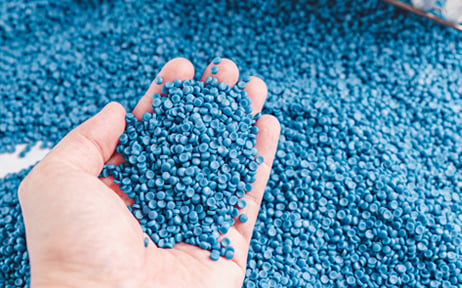
As June 2025 wrapped up, several key developments across the bulk materials landscape caught the attention of industry insiders—though some may have flown under the radar. From delayed wheat harvests due to adverse weather, to shifting dynamics in plastics manufacturing and chemical innovation, and even the ripple effects of SNAP cuts on food producers, the month delivered no shortage of impactful headlines. Add in long-term growth projections for the cocoa sector despite mounting supply pressures, and it’s clear that producers and processors alike are navigating a complex but opportunity-rich environment. Here are five stories you may have missed.
Playing catch-up in wheat harvest
Uncooperative weather conditions during the 2024 U.S. winter wheat harvest caused significant delays, particularly in the eastern Midwest and parts of the southern Plains. Excessive rainfall disrupted harvest schedules, pushing overall progress behind the typical pace for this time of year. Quality concerns also surfaced in several regions, with reports of sprout damage and reduced test weights due to prolonged wet conditions.
Despite these setbacks, the U.S. Department of Agriculture maintained a mostly steady production outlook, expressing hope that improved weather could help farmers catch up. Analysts and millers continued to monitor developments closely, as the harvest’s outcome would affect grain prices and milling quality in the coming months. The situation highlights the industry's need to navigate both environmental hurdles and market demands while working to recover from a sluggish start.
United States Plastics Manufacturing Market Outlook and Forecast 2025-2032
The United States plastics manufacturing market is experiencing robust growth, with a valuation of $124.8 billion in 2024 and projections indicating it will reach $168.5 billion by 2030, reflecting a compound annual growth rate (CAGR) of 5.2%. This expansion is fueled by technological advancements in polymer science and increasing demand across key sectors such as packaging, automotive, and medical devices. Despite challenges posed by sustainability concerns, the industry is actively transitioning toward circular economy models through innovations in recycling and the development of bio-based materials.
Regionally, the market exhibits distinct strengths: the Midwest leads in industrial plastics for automotive applications; the Northeast excels in high-performance polymers for medical and electronic uses; the South has become a hub for packaging due to lower operating costs and strategic distribution networks; and the West Coast, particularly California, is at the forefront of sustainable plastic innovation, implementing stringent recycled content mandates. Key growth drivers include the essential role of plastics in medical devices and food safety, ongoing lightweighting trends in transportation sectors, and emerging technologies that enhance recycling efficiency and bio-based alternatives. However, the industry faces challenges such as volatile crude oil prices affecting feedstock costs, regulatory scrutiny on single-use plastics, and technical barriers in recycling complex materials.
Food manufacturers won’t be spared from SNAP cuts
Planned reductions to the Supplemental Nutrition Assistance Program (SNAP), as outlined in President Donald Trump's budget proposal, are poised to significantly impact major food manufacturers. Companies such as Post Consumer Brands, Tyson Foods, and Conagra Brands are particularly vulnerable, with 10.6%, 8.4%, and 7.7% of their shopping trips, respectively, involving SNAP benefits. Other notable companies like Kraft Heinz, General Mills, and PepsiCo's Frito-Lay also have substantial exposure. These cuts, which include stricter work requirements and cost shifts to states, could result in over 1.3 million Americans losing SNAP benefits, leading to immediate repercussions for these brands.
Consumer behavior is already reflecting these changes. Data from Numerator indicates a year-over-year decline in SNAP or WIC usage across 14 of 20 tracked food and beverage categories for the three months ending April 30. Significant decreases were observed in meat (down 3.4 percentage points), deli and prepared foods (down 2.3 points), snacks (down 1.1 points), candy (down 1 point), and beverages (down 1 point). This trend suggests that SNAP recipients are reducing purchases of higher-cost or discretionary items, potentially affecting sales volumes for manufacturers reliant on these categories.
2025 Chemical Industry Analysis: Trends, Challenges, and Innovations
The 2025 chemical industry is undergoing significant transformation, driven by sustainability, digital innovation, and the pursuit of resilient operations. Key trends include the adoption of green chemistry practices, such as the use of biodegradable materials and bio-based feedstocks, aligning with circular economy principles to reduce environmental impact. Digital transformation is also pivotal, with the integration of Industry 4.0 technologies like AI and IoT enhancing operational efficiency and supply chain transparency.
However, the industry faces challenges, including regulatory complexities, supply chain disruptions, and workforce shortages in specialized fields like chemical engineering and data analytics. To address these issues, companies are investing in localized production, diversifying supplier bases, and implementing continuous training programs. The global chemical market is projected to reach approximately $5 trillion by 2025, with emerging markets in Southeast Asia, Latin America, and Africa playing a significant role in this growth.
Cocoa sector studies forecast key growth into the 2030’s, despite market tests
The global cocoa sector is projected to grow from $13.5 billion in 2023 to $20.8 billion by 2032, with an annual growth rate of 4.9%, according to a study by Dataintelo. This expansion is driven by rising demand for premium and dark chocolate, especially in emerging markets like China, India, and Brazil. Additionally, cocoa's use in bakery, dairy, and beverage industries, along with its health benefits—such as flavonoids and antioxidants—are boosting its popularity. Consumers are increasingly valuing sustainability and ethical sourcing in their purchasing decisions.
Despite this positive outlook, the industry faces challenges, including environmental issues and infrastructure problems. Cocoa prices have been volatile, starting 2025 at around $12,000 per tonne, up from $3,000 two years prior, due to supply deficits. Innovations like lab-grown cocoa are emerging, potentially disrupting traditional production methods. Overall, while the sector is poised for growth, it must navigate these ongoing challenges to sustain its trajectory.


